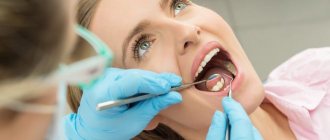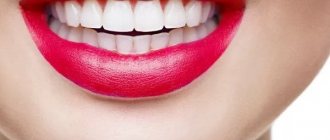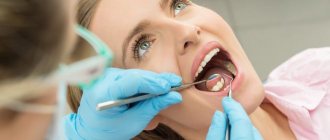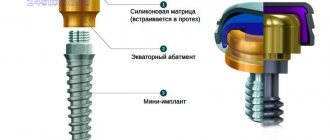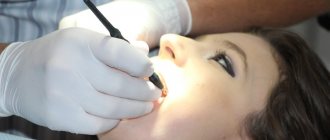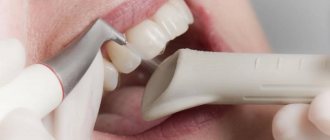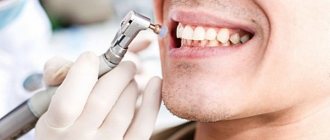Dental hygiene is a necessary measure that allows you to maintain the health and strength of your teeth for a long time. There are many ways to clean teeth in dentistry. One of the most common is polishing teeth with paste. The principle of operation is the complex action of cleaning mechanisms and abrasive pastes. Teeth polishing is done with special tools with rotating heads. As they rotate, they smooth and clean the surface of the tooth. Thus, brushes are preferable on the bumps, as they can damage the gums and soft tissues, and rubber attachments are preferable on the flat surfaces of the tooth, because other places are inaccessible to them.
Just like the type of instrument for the procedure, the doctor selects the paste individually, based on the characteristics of the dental system of a particular patient. Pastes vary in their degree of granularity. Typically, several drugs are used per session, gradually reducing the degree of granularity. Thanks to this, you can achieve the best effect, straighten and make your teeth smooth. After all, the less rough they are, the more difficult it is for plaque to appear on them again. Their composition can be different, but fluorite is often used to strengthen the enamel.
You can polish not only healthy teeth, but also fillings and crowns, which helps get rid of some plaque on them, strengthens their strength and restores color.
Why do you need to polish your teeth?
Despite the fact that grinding and polishing are included in the complex of measures for removing stone, they can also be used as independent procedures aimed at improving the general condition of the enamel. Grinding is performed in order to remove unevenness and microcracks from the enamel surface. Thus, grinding the enamel helps reduce plaque and slows down the formation of stones. In addition, grinding helps improve the general condition of the enamel and is one of the preventive measures for the development of caries. Polishing is carried out after grinding. It is intended for the final leveling of micro-irregularities on the enamel that could remain after grinding. In general, polishing is more cosmetic in nature and provides a slight whitening effect.
Possible consequences
Despite the development of technology, polishing tooth enamel is still not the most pleasant procedure for which you should prepare in advance. To ensure the psychological and physical comfort of the patient, local anesthesia is used to eliminate pain.
It is also worth considering that after treatment, the sensitivity of the enamel increases, so the reaction to sudden temperature changes after the effect of painkillers wears off can be unpleasant. It is recommended to follow medical recommendations that prescribe a temporary exclusion of hot and iced foods and drinks from the diet, as well as a reduction in the amount of solid food, the consumption of which leads to an increase in mechanical stress on weakened enamel.
Polishing pastes
During the procedure, special polishing pastes are used; it is desirable that they contain fluoride preparations for the remineralization of treated dental tissues and weak antiseptic agents. The composition of these pastes is close to the composition of pastes for individual oral care, however, they are more abrasive. The following is used as an abrasive filler:
- pumice,
- silicate or aluminum oxide,
- silica,
- zircon.
Polishing pastes should be available in a full range of grain sizes. They are produced in large tubes or “unidoses” (single doses). To work, it is convenient to place the polishing paste in the ring-shaped holder.
Polishing begins with a coarse polishing paste with a rubber cup, then treatment is carried out with a medium-grained paste, thanks to which the unevenness formed by the previous paste is smoothed out. Only if you follow the order of alternating polishing pastes can you obtain a smoothly polished surface.
Finally, final polishing is carried out with a fine-grained fluorine-containing paste. In addition to the gradation of pastes by grain size, an important indicator is the RDA indicator - radioactively measured dentin abrasiveness. The lower the RDA number, the lower the abrasiveness. The higher this number, the higher the abrasiveness.
Teeth grinding tools
For polishing, special tools with rotating heads are used, which are fixed to the contra-angle tip of the drill. The principle of operation is the complex use of cleaning mechanisms and abrasive pastes.
The following are used as nozzles:
- rubber cups – suitable for treating flat tooth surfaces;
- cone-shaped brushes – designed for lumpy areas;
- polishing strips (strips) coated with aluminum oxide or diamond coating - for cleaning proximal surfaces, that is, the area of contact between the teeth.
During the polishing process, the dentist alternately uses several types of abrasive pastes, ranging from coarse to medium- or fine-grained.
The degree of abrasiveness of the paste is indicated by the RDA index:
- 250 (blue) – coarse-grained mixture for removing dense deposits;
- 170 (green) – medium-grained;
- 120 (red) – fine paste;
- 40 (yellow) – extra soft for final polishing.
The main component (abrasive) of polishing pastes is silica, ground zircon, silicate or zirconium oxide. The preventive effect is provided by such useful components as ionized fluorine and xylitol.
Abrasive tooth polishing paste
Tools for the procedure
Polishing requires special dental instruments. The drill starts at a speed of 2000-5000 rpm, which is safe for the enamel structure. And various attachments are used as the main tool:
- rubber in the shape of cups - help to level all flat surfaces;
- cone-shaped brushes - treat lumpy chewing sides;
- strips (polishing strips) – coated with diamond or aluminum coating for maximum cleaning of interdental spaces.
Required materials and tools
Various materials, tools and the latest technologies are used for polishing. They differ from each other in size, shape, design, etc.
You can include it here:
- use of abrasive pastes;
- strips, discs and polishers;
- finishing stones, abrasive stones;
- brushes and rubber cups.
Below we will look at each type in more detail.
Bors
The main distinguishing feature of burs is the attachments, as well as the material used for production.
There is a special marking that makes it easier to select a bur to perform a particular manipulation:
- diamond burs with a yellow or red ring - allow you to remove excess filling material;
- attachments with white stripes - allow you to polish your teeth until they are smooth.
An example of what burs look like
Carbide burs can also be used and serve as the final step in the restoration.
Finir
These are attachments for drills, made in the form of a spiral. Doctors can polish any material used in dentistry. The number of faces can be different, from six to thirty pieces.
Abrasive stones
These are rotating dental instruments, the material used for manufacturing is different, the degree of roughness also differs from each other.
Other attachments used in dentistry
Polishers
The tool allows for high-quality polishing. The ligament is silicone and elastic, the degree of rigidity is medium. The shape of the polishing element can be conical, cylindrical, or convex.
Strips
These are flexible strips made of polyester. Different materials with varying degrees of grain size can be used as a coating. Length up to 18 centimeters.
Suitable for polishing contact surfaces
Pastes
These are special pastes designed for polishing and cleaning teeth. Available in syringes and tubes. The composition contains fillers with abrasive particles. They can be standard, thin or extra-thin.
Stages of the procedure
Before the procedure, the dentist examines the oral cavity and removes the stone. Next, depending on the condition of the teeth and gums, as well as the presence or absence of contraindications, the doctor chooses one of the methods of performing the procedure and selects the necessary tools and materials. The entire procedure takes about half an hour and does not require anesthesia.
First, the flat lateral surfaces are processed, then the chewing surfaces, and at the end of the procedure, the interdental space is polished. As mentioned above, grinding and polishing is an absolutely painless procedure that does not cause discomfort to patients. However, patients with sensitivity or periodontal disease may experience discomfort during grinding. Grinding and polishing enamel not only does not have a harmful effect on the enamel, but also helps strengthen it, reduces the rate of formation of plaque and stones, and is also one of the methods for preventing caries and inflammatory gum diseases. In addition, polishing removes darkening of the enamel, which significantly improves the color of teeth.
Usually polishing is carried out with an abrasive paste. In this case, special tools with rotating cone-shaped heads are used. There are two types of tools for treating teeth with paste:
- Brushes are coarser, so they are used for grinding that part of the tooth that does not come into contact with the gum;
- Rubber cups have a gentler effect on the enamel, without irritating or injuring the gums.
The abrasive substances used to clean darkened enamel can also be different. They differ in such parameters as:
- Compound;
- Grain level.
Contraindications to teeth polishing
The benefits of polishing for the health and aesthetics of a smile cannot be overestimated. However, at present there are several contraindications to its implementation:
- gum disease;
- caries;
- increased sensitivity of enamel;
- the occurrence of any inflammation in the oral cavity;
- individual intolerance to at least one of the components of the drug;
- adherence to a salt-free diet for renal failure;
- the presence of certain chronic diseases.
Therefore, before undergoing the procedure, it is necessary to consult a dentist.
Recommendations after the procedure
After any activities related to professional teeth cleaning, including after polishing, the patient is recommended to avoid eating foods such as coffee, tea, chocolate, and beets for several days. This is due to the fact that there is a high probability that a polished tooth will acquire the shade of these products. Smoking is also not recommended - ideally you should quit smoking.
Teeth polishing should be carried out no more than once every six months in order to avoid excessive wear of tooth enamel. After this procedure, the doctor should recommend which toothpaste the patient can use. The use of highly abrasive bleaching pastes should be avoided. It is better to use fluoridating pastes.
Are there any contraindications
There are no contraindications for polishing teeth, but procedures that precede this do have them.
For ultrasonic cleaning:
- presence of a pacemaker;
- treatment with immunosuppressants and corticosteroids;
- recent eye surgery;
- epilepsy;
- severe form of diabetes.
For AirFlow:
- taking medications for salt balance;
- hepatitis;
- AIDS;
- sodium-free diet;
- lung diseases, asthma.
In case of infections, diseases of the upper respiratory tract, exacerbation of general conditions, or the presence of ulcers in the mouth, it is worth postponing resurfacing until the condition improves.
How to grind and polish
Since these procedures are mainly the final stage of therapy or cleansing, the doctor first carries out the necessary manipulations. And only after the tartar is cut off and the filling is installed, grinding and polishing begins.
The doctor selects the paste and attachments, focusing on the individual clinical picture. However, the basic principles remain the same: first, flat surfaces are treated, then chewing surfaces, and only then the interdental space.
The doctor also uses pastes in a certain order: first coarse, and then fine-grained. After final polishing, the teeth are coated with a special fluoride varnish to protect the enamel from aggressive bacteria and food acid.
What is polishing
Polishing belongs to the category of professional cleaning. This is a dental procedure that is prescribed after each dental procedure. Polishing has several useful properties:
- Teeth become smooth and white.
- breath disappear .
- Prevents dental diseases.
The polishing procedure ultimately gives not only the external effect of whitening and smoothness, but also disarms the surface of the incisors, providing protection against the development of oral diseases.
Indications for cleaning
After visiting the doctor's office, the patient may be prescribed a polishing. Cases after which the dentist can send for the procedure:
- Installation of implants, fillings.
- whitening .
- Professional clinical enamel cleaning.
- Removal of tartar and visible plaque.
- Comfort after cleaning with products containing abrasive particles.
- Correction of the cutter shape.
- Prevention of irritation of the mucous membrane.
You should not refuse to straighten the enamel; the doctor better understands the condition of the teeth. If the doctor insists on the procedure, then it is really necessary.
